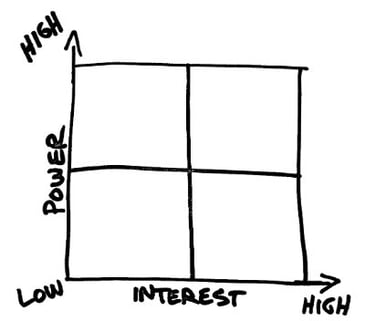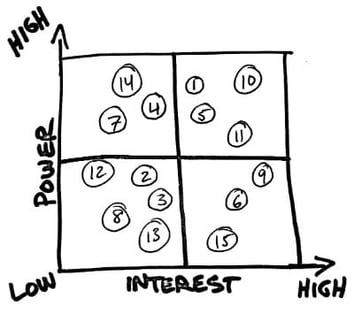
Create a list of everyone who can impact or be impacted by your project. These are individuals or groups who can influence your project in a positive or negative way. Analyze this list and plan how you will communicate with them to increase the positive and decrease the negative impact your stakeholders will have on your project.
One of the best ways to kill a project is to forget a major stakeholder. A stakeholder is any individual or group who is positively or negatively impacted by, or who can positively or negatively impact, your project. Examples in education management include students, parents, principals, assistant principals, the chancellor, the mayor, safety agents, kitchen staff, office staff, the cashier at the corner store, etc. Stakeholders can represent opportunities or threats to a project and must be managed with care.
Generate a List
Before you can perform your stakeholder analysis you and your team must first create a list of all the stakeholders for your project. This can be performed through a simple brainstorming session. Although there is plenty of evidence thatbrainstorming has its limits, I feel that for this type of information gathering, traditional brainstorming is a great tool. Here is a link for "Brainwriting" if you want an innovation on brainstorming that is also effective.
For big projects the list will usually get into the hundreds, if not thousands. For small projects about 20 is common. You should generally stick to titles rather than specific names, since people change titles all the time. Once you have created your list you should number each stakeholder. It should look something like this:
- Students
- PTA Lead
- Kitchen Staff
- Etc.
Perform Stakeholder Analysis
Once you have generated a thorough list of stakeholders who are important to the success of your project you can perform a simple stakeholder analysis. Again, if this was a big project you would use a more complex and nuanced method than this one, but we are aiming for quick and effective for our use. We are going to separate each stakeholder or group into 4 quadrants using a simple graph. You can see an example below. The lower left quadrant is low power and low interest; the upper left quadrant is high power and low interest; the lower right quadrant is low power and high interest; and the upper right corner is the sweet spot of high power and high interest.

Your job now is to sit with your team and determine in which quadrant each stakeholder or group belongs. Take your time with this because where you place them in this grid is going to help you to shape your communication strategies with them in the future. As you are entering them into the grid use their numbers to make it easier. In the end it will look something like this:

Lower left: These stakeholders don't need that much attention. Keep them in your thoughts. Monitor them.
Upper left: Lots of power but little interest. You need to keep these people satisfied. An example might be custodial staff. They have the keys to the rooms. Keep them on your side. If you can increase their interest you might even make them a great advocate and move them over to the upper right quadrant.
Lower right: Keep them informed. They might become ambassadors for you. They might know someone who does have influence and who might have a positive impact on your project.
Upper right: The folks in the upper right quadrant are the ones you need to monitor and manage most closely. You need to involve them in decision making and keep them updated. They are the ones that are most likely to kill your project if they don't like you. Conversely, they are also likely to help you to make it amazing if they are invested in it.
Now Go Forth and Communicate
Now that you have a list and have analyzed how to prioritize your stakeholders you can plan your communications accordingly. Common wisdom holds that 80% of project management is communication and relationship building. This grid can guide you to be intentional about who you communicate with and how often.
To begin putting this analysis to work I recommend scheduling communications for those in the upper right quadrant directly into your calendar. Ask them frequently for feedback. Bring them coffee. By doing this you begin building the relationships that will improve the success rate for this and future projects.
Your next step is to begin asking these stakeholders what they want the project to achieve. Our next blog post demonstrates how to do that. You can click this link to continue.
To read the previous posts in this series, please click on the links below:
Introductory Post: 25 Steps to Small Project Success
Project Step #1: Create a Problem Statement
Project Step #2: Create a Vision Statement
Project Step #3: Create a Mission Statement
Project Step #4: List Milestones
Project Step #5: List Assumptions and Constraints
"Project Step #6: Perform Stakeholder Analysis" by Tom Armstrong, 2016.
Originally published on LinkedIn.



Comments [0]
Click here to read/write comments